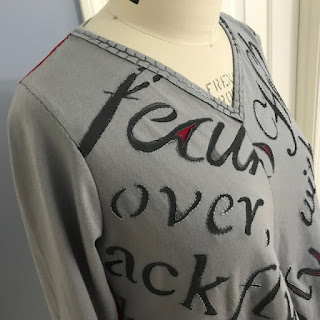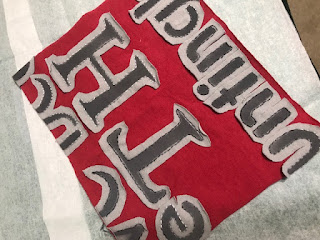When I attended an Alabama Chanin workshop in April, I purchased a second kit. The first kit was included in the class price and the second was discounted, so I had to buy it, right? And I am glad I did. I finished the jacket a while back (blogged here) and I'm just waiting for the weather to turn a bit cooler to start wearing it. This tee shirt has been fun to work on, with only the tiniest of challenges.
The Pattern:
The pattern is labeled the Alabama Sweater. You can make it in 3 lengths. I chose the middle ground with the top. I shortened the sleeves to 3/4 length and raised the neckline about an inch all the way around, maybe more. At this point I'm not sure. The sample I tried on felt way too open in the front. I'm quite bony in that area and more than a little self-conscious. I now think it could have been a little more open, but this is just fine.
The physical pattern is not included in the kit, but the instructions are. There is not much that is challenging about the construction. It is slow-going and portable. And I love that it is entirely made by hand.
The sleeves are sewn in flat rather than in the round. This resulted in a remarkably high armscye - great range of motion and no bunching in the armpit.
I mostly needed the instructions to use in adding their signature binding to this V-neck. Their method is fabulous for these cotton knits! The binding is single layer on both sides, simply wrapped around the raw edge. I basted it on and then worked the cretan (creten?) stitch to secure it. And their method for the V? That is quite fabulous too. I'll be using that technique elsewhere.
The Fabric and Stencil:
The fabric is of course two layers of their organic cotton jersey. The top layer is light gray and the bottom layer is a beautiful red, *my* red with blue undertones.
The stencil is a darker gray or silver, random words and lettering in a variety of fonts and sizes. I asked them to print it diagonally on the fronts and backs, with lots less on the back. In fact, I omitted stenciling entirely on one side of the back. I asked them to print the sleeves partially, as you can see.
Honestly I don't think I would select that stencil again as it does not lend itself to the standard AC technique of sewing around the shapes and cutting away some of the fabric inside the stencil or around it. Some of the shapes were too thin to sew around, so I sewed on top of them. I did sew around most of the letters using a simple running stitch.
Each kit includes an 8x10 double-layer sample with stenciling so that you can determine which of their techniques works best. I tried cutting away the foreground on my sample and learned what I did NOT want to do. To me it looked like a flannel board with letters stuck on.
After completing the outlining of the letters, I slit open the larger letters and even removed miniscule slices of the interior of a few letters. Others I slit, thinking that these will open a bit more when I wash it. I had to leave the smaller ones alone.
When I had completed the construction, except for the hems and neckline, I tried it on. It felt like that blanket I wear at the dentist when they x-ray my teeth, only nicely fitted through the shoulders, bust and arms. I put it away for a while and worked on other projects.
After reassurance from one of you, kind readers, I cut away the bottom layer (the red) from around the lettering. This did not change the appearance at all, but it made it much lighter and quite comfortable to wear. And that plain back just had to change - too much flat gray after the business in the front. So, for now, it is solid red.
I took a class on printing with botanical dyes this past weekend - such fun! I learned some new things about printing, so I now have an idea about a way to keep the red half of the back more in line with the overall design. Just waiting for a few supplies to arrive.
I turned the bottom hem up and stitched it in place with a running stitch which gives it some weight. I had enough red left over from my cutting away the bottom layer to make red binding for the sleeves.
This piece is finished. For now. I may or may not add to the red back half. What do you think? Is it too jarring as is?
Thanks for reading. I hope you are happily making something today.











































